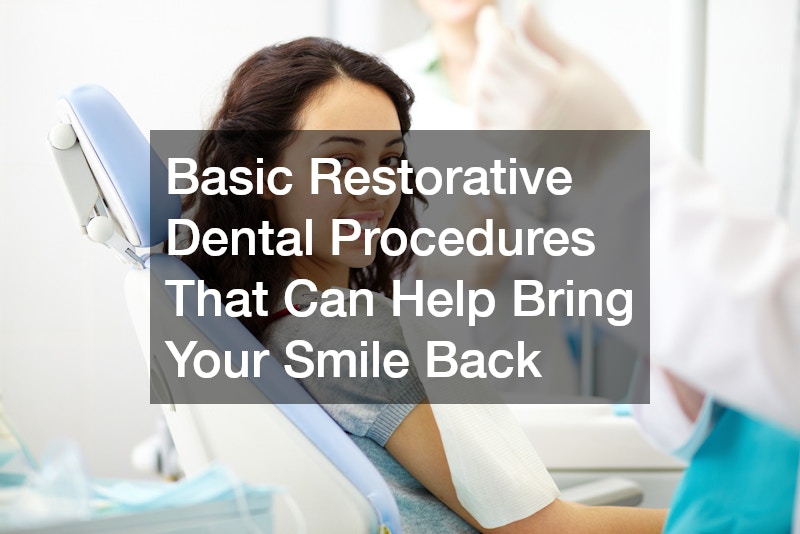
A healthy smile is a reflection of your overall well-being, and it is often the first thing people notice about you. Over time, various factors such as age, accidents, or poor habits can affect the appearance and function of your teeth. However, modern restorative dentistry offers several options to help bring back your smile. Basic restorative dental procedures are designed to restore the functionality, health, and appearance of your teeth. These procedures not only enhance your smile but can also improve your overall oral health. In this article, we will explore the most common basic restorative dental treatments, including teeth cleaning, dental veneers, dental implants, and Invisalign.
1. Teeth Cleaning: The First Step in Basic Restorative Dental Care
One of the fundamental aspects of maintaining a healthy smile is regular teeth cleaning. Often referred to as prophylaxis, this basic restorative dental procedure involves the removal of plaque and tartar from your teeth. Plaque, a sticky substance made of bacteria, forms on teeth and can harden into tartar if left unchecked. Tartar can lead to gum disease, cavities, and other oral health issues. A professional teeth cleaning by a dental hygienist at a dental office can help prevent these problems. Additionally, your dental office will be able to detect early signs of decay, gum disease, or other issues during your cleaning.
Routine teeth cleaning also contributes to the overall aesthetic of your smile. By removing surface stains, teeth cleaning can brighten your smile and prevent discoloration. For individuals with certain cosmetic dental needs, such as dental veneers or dental implants, regular teeth cleaning is an essential part of maintaining the longevity and health of these dental treatments. If you’ve neglected regular visits to your doctor office for teeth cleaning, it’s never too late to get back on track and restore the health of your smile.
2. Dental Implants: A Long-Term Solution for Missing Teeth
Dental implants are one of the most effective and durable solutions for replacing missing teeth. This basic restorative dental procedure involves placing a titanium post into the jawbone to act as a replacement root for the missing tooth. Over time, the bone fuses with the titanium post, creating a strong foundation for a crown or bridge. Dental implants are widely regarded as the best alternative to dentures, providing a permanent, stable, and natural-looking replacement for missing teeth.
Dental implants not only restore the appearance of your smile but also improve oral function. By filling in gaps where teeth are missing, dental implants make it easier to chew and speak. They also help prevent bone loss in the jaw, which can occur when teeth are missing for an extended period. For those looking for a long-term solution, dental implants are often considered the gold standard in basic restorative dental care. If you’re interested in dental implants, your dental office can assess your suitability for this procedure and guide you through the process.
3. Dental Veneers: A Cosmetic Dental Service for a Flawless Smile
For individuals with chipped, stained, or misaligned teeth, dental veneers are a popular option. This basic restorative dental procedure involves placing thin, custom-made shells of porcelain or composite resin over the front surface of your teeth. Dental veneers are an excellent choice for enhancing the appearance of your smile, as they can correct a variety of cosmetic concerns, such as discoloration, gaps, and minor misalignments. Veneers can provide you with a bright, white, and symmetrical smile that looks completely natural.
Many people opt for dental veneers as part of a broader cosmetic dental service, which can also include treatments like teeth whitening, Invisalign, or crowns. One of the advantages of dental veneers is their versatility—they can be used on a single tooth or several teeth to create a uniform smile. Additionally, dental veneers are highly durable and resistant to stains, making them an excellent choice for individuals looking to improve the appearance of their smile without extensive maintenance. If you’re ready to take the next step toward a flawless smile, talk to your dental office about whether dental veneers are right for you.
4. Invisalign: A Modern Approach to Teeth Alignment
For those looking to straighten their teeth without the use of traditional metal braces, Invisalign offers a discreet and comfortable alternative. This basic restorative dental procedure uses a series of clear, custom-made aligners to gradually move your teeth into the desired position. Invisalign is an ideal choice for individuals who are looking to correct minor to moderate orthodontic issues, such as crooked teeth, gaps, or slight bite problems.
Unlike traditional braces, Invisalign aligners are removable, making it easier to maintain proper oral hygiene. You can take the aligners out to brush and floss, which can help prevent plaque buildup and ensure that your teeth remain healthy throughout the treatment process. Invisalign is a popular option for both teens and adults who want to improve the alignment of their teeth without the discomfort or visibility of metal braces. Consult with your dental office to see if Invisalign is a suitable option for your basic restorative dental needs.

5. The Role of Dental Supplies in Restorative Dental Care
To achieve optimal results in restorative dental procedures, dental offices rely on high-quality dental supplies. These supplies range from tools for basic restorative dental procedures, such as fillings and crowns, to advanced equipment for treatments like dental implants and veneers. The use of the latest dental supplies ensures that procedures are performed efficiently and with minimal discomfort to the patient. Whether you are undergoing a simple teeth cleaning or a more complex procedure, the quality of the supplies used plays a significant role in your overall experience and outcome.
Additionally, the use of dental supplies extends beyond the dental office to your at-home care. Toothbrushes, toothpaste, floss, and mouthwash are all considered essential dental supplies for maintaining oral health between visits. A water softener installation in your home can also be beneficial, as soft water is gentler on your teeth and can help reduce the buildup of minerals and plaque. If you’re uncertain about which dental supplies are right for your needs, your dental office can provide recommendations based on your specific oral health requirements.
6. Dental Crowns and Fillings: Basic Restorative Dental Options for Damaged Teeth
Dental crowns and fillings are some of the most common basic restorative dental treatments. They are used to restore teeth that have been damaged by decay, trauma, or wear and tear. A dental crown is a cap that covers a damaged tooth to restore its shape, size, and function. Crowns can be made from a variety of materials, including porcelain, metal, or a combination of both. They are often used for teeth that are severely damaged or weakened, such as after a root canal procedure.
Fillings, on the other hand, are used to fill cavities caused by decay. Dental offices typically offer several types of filling materials, such as amalgam, composite resin, or gold. Each material has its own set of benefits and is chosen based on the location and size of the cavity, as well as the patient’s preferences. Dental crowns and fillings are essential in maintaining the health and integrity of your teeth, as they prevent further damage and restore the functionality of your mouth.
7. Water Softener Installation: An Indirect Benefit for Dental Health
While it may not seem directly related to basic restorative dental care, water softener installation can have a positive impact on your oral health. Hard water, which contains high levels of calcium and magnesium, can leave deposits on your teeth over time. These deposits can contribute to plaque buildup, staining, and even the erosion of tooth enamel. By installing a water softener in your home, you can reduce the effects of hard water on your teeth and ensure that your smile stays bright and healthy.
In addition to improving the health of your teeth, softened water can also make other aspects of dental care easier. For example, using softened water for brushing and rinsing can help reduce the wear on your toothbrush bristles and prevent the accumulation of mineral buildup on your dental appliances, such as retainers or Invisalign aligners. It’s a small investment that can make a significant difference in the long-term health of your smile.
8. Root Canals: A Vital Part of Basic Restorative Dental Care
Root canal therapy is a commonly performed basic restorative dental procedure designed to save a tooth that has become infected or severely decayed. When the inner pulp of a tooth becomes inflamed or infected due to deep cavities, trauma, or repeated dental procedures, a root canal may be necessary. During the procedure, the dentist removes the infected pulp and seals the cavity to prevent further infection. In many cases, a dental crown is placed over the treated tooth to restore its structure and functionality.
Root canal therapy has a reputation for being a difficult and painful procedure, but advancements in modern dental techniques have made it much more comfortable and efficient. It’s important to note that a root canal is often the best option for preserving the tooth and preventing the need for an extraction. By opting for a root canal, you can maintain your natural teeth and avoid complications that can arise from tooth loss. If you suspect you need a root canal, don’t hesitate to consult your dental office to explore your options and maintain the health of your smile.
9. Cosmetic Dental Services: Enhancing the Aesthetics of Your Smile
Cosmetic dental services have become an increasingly popular way to enhance the appearance of your teeth while maintaining their health. These services include a variety of procedures designed to improve the color, shape, and alignment of your smile. Basic restorative dental procedures, such as teeth whitening, dental veneers, and Invisalign, all fall under the umbrella of cosmetic dental services. These treatments are often performed in combination with other restorative procedures to create a comprehensive smile makeover.
For example, a patient may undergo teeth cleaning to ensure a healthy foundation, followed by Invisalign treatment to straighten the teeth, and finish with dental veneers for a flawless finish. By combining different cosmetic dental services, you can achieve a smile that not only looks beautiful but functions well too. Many dental offices offer packages for cosmetic services, so it’s worth discussing your options with your dentist to find the best treatment plan for your needs. A perfect smile doesn’t just improve aesthetics—it can also boost your self-confidence and help you feel better about yourself.

10. The Importance of Regular Check-ups: Preventing the Need for Extensive Restorative Work
Regular dental check-ups are essential in preventing the need for extensive basic restorative dental work down the road. By visiting your dental office at least twice a year for routine exams and teeth cleaning, you give your dentist the opportunity to catch any potential issues early. During these check-ups, your dentist will thoroughly examine your teeth and gums, looking for signs of cavities, gum disease, or other problems that could lead to the need for more complex procedures, such as root canals, implants, or crowns.
Prevention is the key to maintaining oral health, and regular visits to your doctor office can help you avoid extensive restorative treatments. In addition to detecting early signs of decay and gum disease, your dentist can provide personalized recommendations for at-home care, such as which dental supplies to use or how often to floss. A proactive approach to dental care ensures that your smile remains healthy and beautiful for years to come, reducing the likelihood of needing more invasive restorative procedures.
Conclusion: Restoring Your Smile with Basic Restorative Dental Procedures
Restoring your smile involves more than just cosmetic enhancements—it’s about maintaining the overall health and function of your teeth. Basic restorative dental procedures like teeth cleaning, dental implants, veneers, and Invisalign can help you achieve a beautiful, healthy smile that you can be proud of. By choosing the right dental services and maintaining regular visits to your dental office, you can address any oral health concerns and ensure that your teeth remain in optimal condition. Whether you’re looking to improve the appearance of your smile or restore functionality, there is a basic restorative dental procedure that can help.
From routine teeth cleaning to advanced options like dental implants and veneers, the field of restorative dentistry offers a wide array of solutions tailored to meet your needs. By incorporating these treatments into your dental care routine, you can keep your smile looking its best for years to come.



